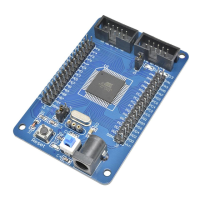112
2467S–AVR–07/09
ATmega128
16-bit
Timer/Counter
(Timer/Counter
1 and
Timer/Counter3
)
The 16-bit Timer/Counter unit allows accurate program execution timing (event management),
wave generation, and signal timing measurement. The main features are:
•
True 16-bit Design (i.e.,Allows 16-bit PWM)
• Three Independent Output Compare Units
• Double Buffered Output Compare Registers
• One Input Capture Unit
• Input Capture Noise Canceler
• Clear Timer on Compare Match (Auto Reload)
• Glitch-free, Phase Correct Pulse width Modulator (PWM)
• Variable PWM Period
• Frequency Generator
• External Event Counter
• Ten Independent Interrupt Sources (TOV1, OCF1A, OCF1B, OCF1C, ICF1, TOV3, OCF3A, OCF3B,
OCF3C, and ICF3)
Restrictions in
ATmega103
Compatibility Mode
Note that in ATmega103 compatibility mode, only one 16-bit Timer/Counter is available
(Timer/Counter1). Also note that in ATmega103 compatibility mode, the Timer/Counter1 has two
Compare Registers (Compare A and Compare B) only.
Overview Most register and bit references in this section are written in general form. A lower case “n”
replaces the Timer/Counter number, and a lower case “x” replaces the Output Compare unit
channel. However, when using the register or bit defines in a program, the precise form must be
used i.e., TCNT1 for accessing Timer/Counter1 counter value and so on.
A simplified block diagram of the 16-bit Timer/Counter is shown in Figure 46. For the actual
placement of I/O pins, refer to “Pin Configurations” on page 2. CPU accessible I/O Registers,
including I/O bits and I/O pins, are shown in bold. The device-specific I/O Register and bit loca-
tions are listed in the “16-bit Timer/Counter Register Description” on page 133.

